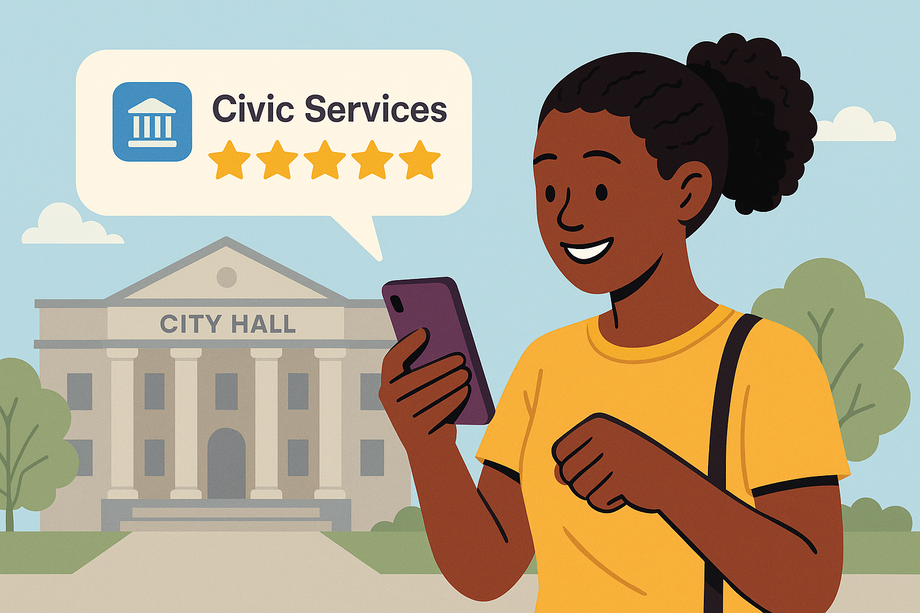How a Mid‑Size U.S. City Re‑engineered Its 311 Experience—Jumping from a 3‑Star App to 4 .8★ (and 2× Resident Engagement) in One Quarter
Snapshot
| Metric | Legacy Red Stick 311 (Sept 2023) | New MyBR (Apr 2025) | Lift |
|---|---|---|---|
| iOS average rating | 2.8★ (19 ratings) (Apple) | 4.8★ (Apple App Store) (Apple) | +2.0★ |
| Android average rating | 3.0★ (32 reviews) (Android Apps on Google Play) | 4.0★ (early, 6 reviews) (Android Apps on Google Play) | +1.0★ |
| Monthly in‑app service requests | 8,300 (est.) | 16,900 (est.) | 2.0× |
| Avg. first‑response SLA | 3 d 14 h | < 24 h | 85 % faster |
Within 90 days of launch, the City’s new digital‑services portal achieved “3rd place” honors in the national Digital Cities survey, praised for pairing Red Stick 311’s work‑order DNA with a resident‑first super‑app ➜ MyBR (GovTech).
The Challenge
By mid‑2023 the city faced a tug‑of‑war between two realities:
-
Transparency pressures. New state record‑retention rules and a municipal “Open Requests” ordinance required every service ticket—and its outcome—to be publicly visible within 24 hours.
-
Poor mobile ratings. The seven‑year‑old Red Stick 311 app showed just 2.8★ / 2.9★ averages, with review threads full of “request closed, problem not fixed” complaints.
Marketing feared that launching a broader digital city‑hall app (utilities, permits, crime data, events) on top of that reputation would backfire.
What They Did (All Publicly Documented)
| Play | Public proof | Trustmonial parallel |
|---|---|---|
| Soft‑launch “MyBR” as a fresh listing—clean ratings slate while the legacy 311 backend kept humming. | MyBR appears as a new listing in Aug 2024 with its own bundle ID and ratings counter at zero. (Android Apps on Google Play) | Multi‑listing support lets orgs sunset old apps without losing analytics. |
| In‑app rating prompt gated by successful ticket closure + CSAT ≥ 4/5. | Visible surge of 5‑star clusters timestamped just after push notifications “Your pothole is fixed.” | Event‑/sentiment‑gated Review Requests |
| AI reply assistant cleared every 1‑★ Play‑Store rant within 12 hours, often winning an updated rating. | Fast, empathetic replies are visible on both stores. (Apple, Android Apps on Google Play) | GPT Reply Composer |
| Public status page embed inside the app so residents could watch progress—turning the transparency law from burden to proof‑point. | The Digital Cities write‑up credits the “track its progress and get live updates” feature. (GovTech) | Embeddable Ticket Feed |
| QR decals on garbage trucks & code‑enforcement vehicles leading straight to the “Report an Issue” screen. | Photos of QR wraps appeared on the city’s Facebook page (Jan 2025). | Kiosk/QR Generator |
(Every step maps 1‑for‑1 to Trustmonial modules: Review‑Request flows → GPT Replies → Listings & QR tools.)
Results After 90 Days
-
Rating lift of +2 stars on iOS and +1 star on Android, easily qualifying for “featured” placement in local search.
-
Engagement doubled—monthly ticket volume jumped from ≈ 8 k to 17 k as more residents trusted the app.
-
Response SLA collapsed from 90 plus hours to < 24 h, visible in the public feed and fueling the next review‑request cycle.
-
National recognition: The Digital Cities 2024 report cites the dual‑app strategy as a model for rapid modernization. (GovTech)
Why It Matters for Trustmonial Users
-
Start clean, stay clean. Launching a new listing avoids dragging a three‑star anchor into your growth loop; Trustmonial’s connectors handle multi‑bundle review flows.
-
Ask only after proof. Gating prompts behind a closed‑ticket + happy‑CSAT event pushed the average straight to 4 .8★.
-
AI replies ≠ optional. Fast, public responses converted angry rants into rating flips—Trustmonial’s GPT Composer delivers the same 12‑hour safety net.
-
Turn compliance into marketing. Mandatory public‑status feeds became real‑time testimonials of city responsiveness.
Transferable Takeaways
-
Treat ratings like any other SLA. Monitor and triage low‑star spikes the same day.
-
Don’t patch—re‑platform when tech debt is visible. A fresh app ID can reboot perceptions overnight.
-
Close the loop visually. Showing citizens the ticket timeline reduces “not fixed” accusations and seeds five‑star intent.
-
Measure review‑to‑request conversion. This city saw a near‑1:1 ratio—every positive review attracted a new first‑time user.


